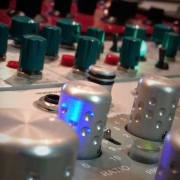The technique of mid-side processing comes from the same concept that has been used when combining a unidirectional microphone with a bidirectional microphone in order to capture a stereo field during recording. When mastering a stereo recording we will need to encode an existing stereo field into mono (M) and stereo (S) components so that that they can be processed or mixed separately, and then decode them back to stereo.
Encoding
To create the mono component simply combine the left and right channels in phase:
M = L+R
To create the stereo component, combine the left channel with a right channel that is opposite in polarity. By doing this you are removing the elements of the stereo field that are common between the two channels (since they are 180 degrees out of phase) leaving only the stereo portion of the signal:
S = L-R
Decoding
Decoding the M and S signal is the same process used by M-S matrix systems and can also be accomplished by using three faders of a console.
Send the M signal to fader 1 panned center.
Send the S signal to fader 2 panned left.
Send the S signal to fader 3 with the polarity reversed and pan right.
The result of doing this is:
Left channel = M+S or substituting the formulas from above
(L+R) + (L-R) = 2L
Right channel = M-S or
(L+R) – (L-R) = L + R – L +R = 2R
You will then need to decrease both the left and right channels by 1/2 (6dB) so that the level is the same as the original.
To accomplish this in Pro Tools I do the following:
Encoding
Take the stereo source track and output to bus 1 and 2. Create 2 stereo aux tracks (M and S). In each aux track set the input to both bus 1 and 2, and insert a plug-in that is capable of reversing one of the channels. I use the time adjuster plug-in for this, but any EQ or compressor plug-in that supports a polarity change will also work fine. Be sure to insert the same plug-in in both tracks or the latency between the plug-ins might be different which may cause a phasing problem. For the M stereo track leave both sides of the plug-in in phase and output to bus 3. For the S channel reverse the right channel of the plug-in and output to bus 4. Also reduce the level of both M and S faders by 6 dB to avoid clipping and to provide the reduction needed so that the output is not doubled.
Decoding
Again create 2 stereo aux tracks, set the inputs for both to bus 3 and 4. The first one we will use as L and the second as R. On the L channel keep both sides in phase, on the right channel reverse the phase of the right side of the plug-in. The outputs from these channels can then go directly to another stereo aux track (set inputs on bus 5/6) for further processing, or you can send the output directly to an interface by hard panning the L track left, and R track right.
Once all of this is setup, try reducing the M and S channels to hear the effect. Reducing M should make the stereo field sound “wider”, increasing it more “monophonic”. Next try inserting various plug-ins in both the M and S channels. You can bypass the plug-in in the channel where you are not going to use the effect for, it’s just there to ensure that the latency is the same between both channels. Listen to the effect of EQing or compressing the mid channel versus the S channel.You can also try using other plug-ins rather than the normal EQ or compressor and automating the M or S channels (handy for specific issues in a mix, like de-essing the lead vocal on the chorus of the song).

